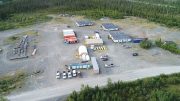Renewable energy will drive demand growth for copper over the coming years, according to a recent study by BMO Capital Markets.
“The need to connect significant numbers of small-scale, electricity-generation units into the grid provides a major boost to copper, with solar generation capacity set to triple and wind capacity set to double by 2025.”
Global copper demand is 30 million tonnes per year. BMO forecasts copper demand growth rates through 2030 will be above a 3% compound annual growth rate, “marking an acceleration on the growth rates seen over the past 20 years.”
As a result, BMO has added 1 million tonnes a year of global copper consumption through 2025, compared with its earlier estimates.
“We see the need for 5 million tonnes per year of new projects from new primary mine supply to solve the expected supply gap and bring the market into equilibrium over the 2025–2030 period.”
BMO has raised its long-run copper price to US$3.25 per pound (US$7,165 per tonne).

Surface facilities at Codelco’s Chuquicamata underground mine, under construction in Chile. Credit: Codelco.
“Changing long-run commodity prices should be a rare event, and should only take place where there is a market shift in the future outlook,” the study reported. “That event is the step-change we expect in demand expectations, driven by renewables and electric vehicles.”
The numbers indicate that infrastructure and electrical networks make up 35% of copper demand, while construction makes up 24%; goods and consumer products, 24%; machinery, 10%; and transportation, 7%.
BMO forecasts renewable grid infrastructure will account for 74% of all copper demand growth to 2025.
The growth in copper demand is happening at a time when “the current and highly probable copper pipeline is at the lowest level we have seen this century, both in terms of the number of projects and capacity,” the study stated.
Existing assets also suffer from lower grades and underperformance.
“Twenty years ago, the average grade of a working copper mine was 1.6%,” the study’s authors note. “Now, it is 1%.”

Solar panels at B2Gold’s 7-megawatt solar power plant at the Otjikoto gold mine in Nambia. Credit: Iamgold.
“The perennial struggles of existing copper assets, particularly the large operations, have posed the biggest hurdle to overall supply growth,” the study states. “To put this in context, the largest 10 copper mines in the world in 2007 produced 4.8 million tonnes of copper [in 2005 this number was in excess of 5 million tonnes]. Those same operations in 2017 produced 4.3 million tonnes.
“We have slight growth [pre-disruption] from existing assets through 2021, but after this point — with many SX-EW operations hitting end-of-life — the decline accelerates. By 2025, we see a drop of 1.53 million tonnes per year from existing operations.”






Be the first to comment on "Renewable energy to drive copper demand, BMO says"